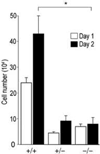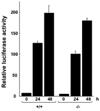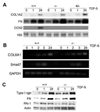Connective tissue growth factor/CCN2-null mouse embryonic fibroblasts retain intact transforming growth factor-beta responsiveness
- PMID: 18201696
- PMCID: PMC3963386
- DOI: 10.1016/j.yexcr.2007.12.010
Connective tissue growth factor/CCN2-null mouse embryonic fibroblasts retain intact transforming growth factor-beta responsiveness
Abstract
Background: The matricellular protein connective tissue growth factor (CCN2) has been implicated in pathological fibrosis, but its physiologic role remains elusive. In vitro, transforming growth factor-beta (TGF-beta) induces CCN2 expression in mesenchymal cells. Because CCN2 can enhance profibrotic responses elicited by TGF-beta, it has been proposed that CCN2 functions as an essential downstream signaling mediator for TGF-beta. To explore this notion, we characterized TGF-beta-induced activation of fibroblasts from CCN2-null (CCN2(-/-)) mouse embryos.
Methods: The regulation of CCN2 expression was examined in vivo in a model of fibrosis induced by bleomycin. Cellular TGF-beta signal transduction and regulation of collagen gene expression were examined in CCN2(-/-) MEFs by immunohistochemistry, Northern, Western and RT-PCR analysis, immunocytochemistry and transient transfection assays.
Results: Bleomycin-induced skin fibrosis in the mouse was associated with substantial CCN2 up-regulation in lesional fibroblasts. Whereas in vitro proliferation rate of CCN2(-/-) MEFs was markedly reduced compared to wild type MEFs, TGF-beta-induced activation of the Smad pathways, including Smad2 phosphorylation, Smad2/3 and Smad4 nuclear accumulation and Smad-dependent transcriptional responses, were unaffected by loss of CCN2. The stimulation of COL1A2 and fibronectin mRNA expression and promoter activity, and of corresponding protein levels, showed comparable time and dose-response in wild type and CCN2(-/-) MEFs, whereas stimulation of alpha smooth muscle actin and myofibroblast transdifferentiation showed subtle impairment in MEFs lacking CCN2.
Conclusion: Whereas endogenous CCN2 plays a role in regulation of proliferation and TGF-beta-induced myofibroblast transdifferentiation, it appears to be dispensable for Smad-dependent stimulation of collagen and extracellular matrix synthesis in murine embryonic fibroblasts.
Figures









Similar articles
-
TNF-alpha, but not IFN-gamma, regulates CCN2 (CTGF), collagen type I, and proliferation in mesangial cells: possible roles in the progression of renal fibrosis.Am J Physiol Renal Physiol. 2007 Jul;293(1):F157-65. doi: 10.1152/ajprenal.00508.2006. Epub 2007 Mar 20. Am J Physiol Renal Physiol. 2007. PMID: 17376761
-
CCN2 is necessary for the function of mouse embryonic fibroblasts.Exp Cell Res. 2007 Mar 10;313(5):952-64. doi: 10.1016/j.yexcr.2006.12.006. Epub 2006 Dec 23. Exp Cell Res. 2007. PMID: 17239853
-
TGF-beta1-induced connective tissue growth factor (CCN2) expression in human renal proximal tubule epithelial cells requires Ras/MEK/ERK and Smad signalling.Nephron Exp Nephrol. 2005;100(4):e156-65. doi: 10.1159/000085445. Epub 2005 Apr 25. Nephron Exp Nephrol. 2005. PMID: 15855807
-
Pathogenesis of fibrosis: role of TGF-beta and CTGF.Curr Opin Rheumatol. 2002 Nov;14(6):681-5. doi: 10.1097/00002281-200211000-00009. Curr Opin Rheumatol. 2002. PMID: 12410091 Review.
-
TGF-β signaling in fibrosis.Growth Factors. 2011 Oct;29(5):196-202. doi: 10.3109/08977194.2011.595714. Epub 2011 Jul 11. Growth Factors. 2011. PMID: 21740331 Free PMC article. Review.
Cited by
-
Fell-Muir lecture: Connective tissue growth factor (CCN2) -- a pernicious and pleiotropic player in the development of kidney fibrosis.Int J Exp Pathol. 2013 Feb;94(1):1-16. doi: 10.1111/j.1365-2613.2012.00845.x. Epub 2012 Oct 30. Int J Exp Pathol. 2013. PMID: 23110747 Free PMC article.
-
Conjunction junction, what's the function? CCN proteins as targets in fibrosis and cancers.Am J Physiol Cell Physiol. 2020 Jun 1;318(6):C1046-C1054. doi: 10.1152/ajpcell.00028.2020. Epub 2020 Mar 4. Am J Physiol Cell Physiol. 2020. PMID: 32130070 Free PMC article. Review.
-
Possible strategies for anti-fibrotic drug intervention in scleroderma.J Cell Commun Signal. 2011 Jun;5(2):125-9. doi: 10.1007/s12079-011-0122-6. Epub 2011 Jan 29. J Cell Commun Signal. 2011. PMID: 21484189 Free PMC article.
-
CYR61/CCN1 expression in resected pancreatic ductal adenocarcinoma: A retrospective pilot study of the interaction between the tumors and their surrounding microenvironment.Heliyon. 2020 May 3;6(5):e03842. doi: 10.1016/j.heliyon.2020.e03842. eCollection 2020 May. Heliyon. 2020. PMID: 32395647 Free PMC article.
-
In perspective: murine models of scleroderma.Curr Rheumatol Rep. 2008 Jul;10(3):173-82. doi: 10.1007/s11926-008-0030-9. Curr Rheumatol Rep. 2008. PMID: 18638424 Review.
References
-
- Jimenez SA, Derk CT. Following the molecular pathways toward an understanding of the pathogenesis of systemic sclerosis. Ann Intern Med. 2004 Jan 6;140(1):37–50. - PubMed
-
- Massague J, Gomis RR. The logic of TGF-beta signaling. FEBS Lett. 2006 May 22;580(12):2811–2820. - PubMed
-
- Moustakas A, Heldin CH. Non-Smad TGF-beta signals. J Cell Sci. 2005 Aug 15;118:3573–3584. - PubMed
-
- Perbal B. CCN proteins: multifunctional signalling regulators. Lancet. 2004 Jan 3;363(9402):62–64. - PubMed
Publication types
MeSH terms
Substances
Grants and funding
LinkOut - more resources
Full Text Sources
Miscellaneous

